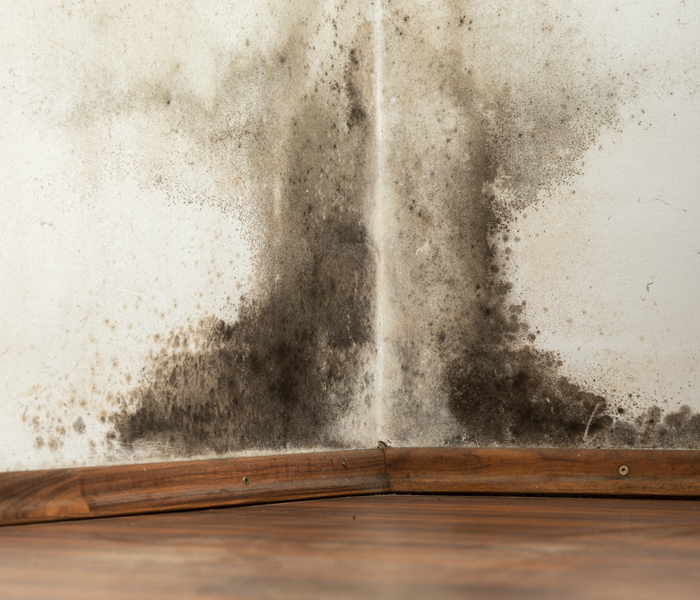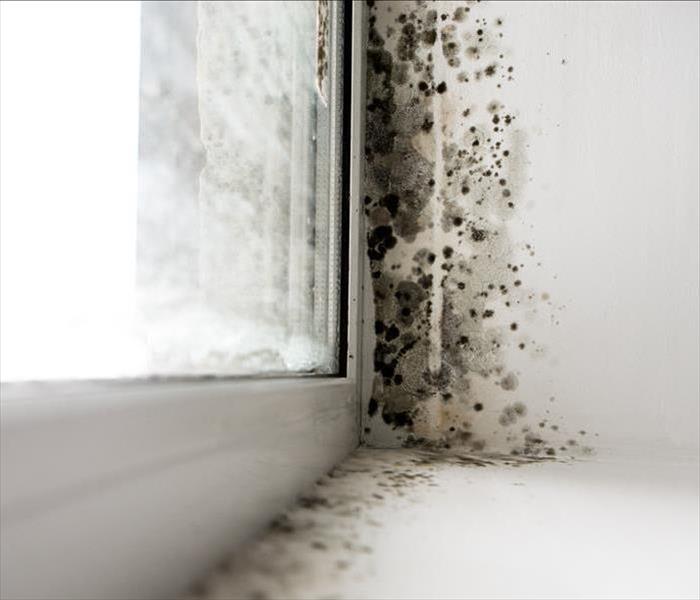Recent Mold Remediation Posts
Mold vs. Mildew: What's the Difference?
7/11/2024 (Permalink)
In indoor environments, the terms "mold" and "mildew" are often used interchangeably to describe fungal growth on surfaces. While both mold and mildew are types of fungi that thrive in damp and humid conditions, they have distinct characteristics and growth patterns. Understanding the differences between mold and mildew can help homeowners and property owners identify and address fungal growth effectively. In this blog, we'll explore the key differences between mold and mildew and discuss how to differentiate between the two.
What is Mold?
Mold is a type of fungus that grows in multicellular filaments known as hyphae. It typically appears as fuzzy or powdery patches of green, black, blue, or gray on surfaces such as walls, ceilings, and building materials. Mold thrives in damp, dark, and poorly ventilated environments and can spread rapidly if not addressed promptly. Common indoor mold species include Aspergillus, Penicillium, Cladosporium, and Stachybotrys chartarum (black mold).
What is Mildew?
Mildew is a type of fungus that grows in flat, powdery patches on surfaces such as walls, fabrics, and plant leaves. Unlike mold, mildew typically remains on the surface of materials and does not penetrate deeply. Mildew is often white or gray in color and may appear as a thin film or powdery residue. It thrives in warm, humid, and poorly ventilated environments and is commonly found in bathrooms, kitchens, and other moisture-prone areas.
Key Differences Between Mold and Mildew
- Appearance: Mold typically appears as fuzzy or velvety patches of various colors, including green, black, blue, or gray. Mildew, on the other hand, appears as flat, powdery patches that are usually white or gray in color.
- Texture: Mold has a fuzzy or velvety texture due to the presence of multicellular filaments known as hyphae. Mildew has a powdery or fluffy texture and tends to remain on the surface of materials.
- Depth of Growth: Mold can penetrate deeply into porous materials such as drywall, wood, and fabric, making it more difficult to remove. Mildew typically remains on the surface of materials and does not penetrate deeply.
- Environmental Conditions: Mold thrives in damp, dark, and poorly ventilated environments with high humidity levels. Mildew prefers warm, humid, and poorly ventilated conditions but can also develop on surfaces exposed to moisture.
How to Differentiate Between Mold and Mildew
- Color: Mold is typically green, black, blue, or gray in color, while mildew is usually white or gray.
- Texture: Mold has a fuzzy or velvety texture, while mildew has a powdery or fluffy texture.
- Depth of Growth: Mold tends to penetrate deeply into porous materials, while mildew remains on the surface.
- Location: Mold is commonly found on walls, ceilings, and building materials, while mildew is often found on surfaces such as fabrics, plant leaves, and bathroom tiles.
While mold and mildew are both types of fungi that thrive in damp and humid conditions, they have distinct characteristics and growth patterns. By understanding the differences between mold and mildew, homeowners and property owners can identify and address fungal growth effectively, maintaining a healthy indoor environment for occupants. SERVPRO® is just a phone call away when you need expert assistance in mold removal, remediation, and restoring your home from mold damage.
Unveiling Mold's Blueprint: The Science Behind Growth and Spores
3/10/2024 (Permalink)
Mold, an ancient and resilient organism, follows a distinct set of principles when it comes to growth and reproduction. In this blog, we will delve into the science behind mold, exploring the ideal conditions for its growth and the remarkable role of spores.
The Mold Life Cycle
Mold undergoes a lifecycle that encompasses various stages, from spore germination to the development of mature colonies. Understanding this lifecycle sheds light on the conditions mold requires to thrive.
Mold thrives in environments that offer three key elements: moisture, a food source, and favorable temperatures. These conditions create a habitat conducive to mold colonization.
Moisture
Moisture is a fundamental requirement for mold growth. Whether derived from leaks, high humidity, or damp materials, mold utilizes water as a catalyst for germination and sustained development.
Mold relies on organic materials as a food source. Common materials like wood, drywall, fabrics, and paper provide the nutrients mold needs to grow and reproduce.
Temperature Range
Mold exhibits versatility in its temperature preferences. While some molds thrive in warmer conditions, others can endure and proliferate in cooler environments. The range generally falls between 40°F and 100°F (4°C to 38°C).
Mold spores are microscopic structures responsible for mold reproduction. These tiny, lightweight spores serve as nature's silent carriers, facilitating the spread and survival of mold.
Reproduction through Spores
Mold reproduces by releasing spores into the environment. These spores can remain dormant for extended periods until they encounter conditions suitable for germination. Once activated, they initiate the growth of new mold colonies.
Mold spores are adept at airborne dispersal. They can travel through the air over long distances, hitching rides on air currents, ventilation systems, or even clothing. This mobility allows mold to colonize new areas efficiently.
Environmental Resilience
Mold spores demonstrate remarkable resilience to environmental conditions. They can withstand harsh temperatures, low humidity, and other adversities, ensuring their survival until they find a suitable environment for germination.
When mold spores encounter the ideal conditions of moisture, a food source, and appropriate temperatures, they germinate and develop into mature colonies. These colonies, if unchecked, can lead to visible signs of mold growth on surfaces.
Preventing Mold
Moisture Control
Implement effective moisture control strategies, including prompt repairs of leaks and adequate ventilation, to deter the conditions favorable for mold growth.
Regular Inspections
Conduct routine inspections of susceptible areas in your home, such as basements, crawl spaces, and attics, to identify and address potential moisture sources.
Humidity Management
Maintain optimal indoor humidity levels through the use of dehumidifiers, ventilation, and proper insulation to discourage mold colonization.
Swift Remediation
If mold is detected, take swift remediation measures to address the root cause, remove affected materials, and prevent further growth.
Understanding the science behind mold growth and spores unveils the intricate mechanisms that guide this resilient organism. By comprehending the conditions that mold requires for proliferation, individuals can proactively implement measures to create an environment less conducive to its establishment. Through effective moisture control, regular inspections, and swift remediation, homeowners can navigate the complexities of mold's existence and maintain a healthier living space. SERVPRO® is just a phone call away when you need expert assistance in mold removal, remediation, and restoring your home from mold damage.
Preventing Mold in Drywall: Effective Strategies for a Mold-Free Environment
11/7/2023 (Permalink)
 Mold growth can be challenging without the proper repair methods.
Mold growth can be challenging without the proper repair methods.
Mold growth in drywall can compromise the structural integrity of buildings and impact their aesthetics. In this blog, we will explore how to identify mold in drywall and discuss effective repair methods. Understanding the signs of mold infestation and implementing proper remediation techniques can help homeowners and businesses maintain a safe and visually appealing environment.
Identifying Mold in Drywall
Detecting mold growth in drywall is crucial in addressing the issue promptly. Look for visual signs such as discolored patches, fuzzy or slimy textures, and a musty odor. Mold can thrive in areas with high humidity, water leaks, or poor ventilation. Pay particular attention to areas near plumbing fixtures, windows, and basements. Since mold can grow within the drywall as well, it may not always be visible on the surface. Conducting air quality tests by professionals can help determine the presence of hidden mold. Identifying mold in drywall early on can prevent further spread and damage.
Repairing Mold-Infested Drywall
Remedying mold-infested drywall requires a systematic approach. Begin by addressing any moisture sources or leaks to prevent future mold growth. Gather the necessary tools, including gloves, goggles, and a mask, to protect yourself during the repair process. Small areas of mold on drywall can be cleaned using an antimicrobial solution or a mixture of water and detergent. Scrub the affected area gently and allow it to dry thoroughly. If the mold has deeply penetrated the drywall or if the affected area is larger than approximately 10 square feet, it is advisable to seek professional assistance for proper removal and replacement of the affected drywall. Following the repair, ensure the area remains dry and properly ventilated to prevent future mold growth.
Preventative Measures
In addition to addressing mold growth in drywall, it is crucial to implement preventive measures to avoid future infestations. Ensuring proper ventilation in moisture-prone areas, such as bathrooms and kitchens, can help reduce humidity levels and discourage mold development. Regularly inspecting and maintaining plumbing systems, roof and window seals, and addressing any water leaks promptly can also prevent moisture accumulation within the drywall. Completing tasks such as sealing cracks and openings in the walls, using mold-resistant drywall or paints, and installing dehumidifiers in humid climates can further enhance mold prevention efforts. By taking these preventive measures, you can minimize the risk of mold growth in your drywall and create a healthier and more resilient living or working environment.
Mold growth in drywall can be a challenging issue, but with proper identification and repair methods, it can be effectively resolved. Being vigilant in detecting mold in drywall, addressing moisture sources promptly, and employing appropriate remediation techniques will help maintain the structural integrity and aesthetics of your living or working space.
Understanding the Accuracy of Mold Home Testing Kits
5/30/2023 (Permalink)
 The accuracy of mold home testing kits can vary widely.
The accuracy of mold home testing kits can vary widely.
The accuracy of mold home testing kits can vary widely depending on several factors, including the quality of the kit, the type of sample collected, and the interpretation of the results. Here are some important things to keep in mind when using a mold home testing kit.
Mold is everywhere
It's important to understand that mold is present in the air and on surfaces everywhere, and some mold spores are always present indoors. Therefore, even if a mold test comes back positive, it doesn't necessarily mean that there is a significant mold problem in your home.
Different kits have different levels of accuracy
Mold home testing kits can vary widely in their accuracy and reliability. Some kits may provide more detailed and accurate results than others. Before purchasing a kit, it's important to research the brand and read reviews to determine its reliability.
Sampling technique
The way you collect the sample can also impact the accuracy of the results. For example, if you don't collect the sample correctly, you may not get an accurate reading of the mold levels in your home.
Interpreting the results
It's important to interpret the results of a mold home testing kit carefully. Some kits may provide a visual indicator that can be difficult to interpret, while others may require you to send the sample to a lab for analysis. It's important to understand what the results mean and what actions you should take based on the results.
Professional mold testing
If you're concerned about mold in your home, it's often best to hire a professional mold testing company to perform an inspection. Professional mold testing companies can provide a more accurate and comprehensive assessment of mold levels in your home and recommend appropriate remediation measures.
Mold home testing kits can be a useful tool for homeowners to monitor the presence of mold in their homes. However, it's important to understand their limitations and potential drawbacks, including their accuracy and reliability. If you're concerned about mold in your home, it's often best to consult with a professional mold testing company to get a more accurate and comprehensive assessment of your home's mold levels.






 24/7 Emergency Service
24/7 Emergency Service

